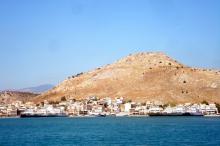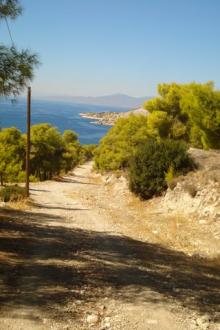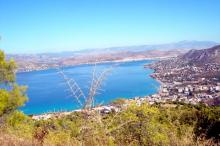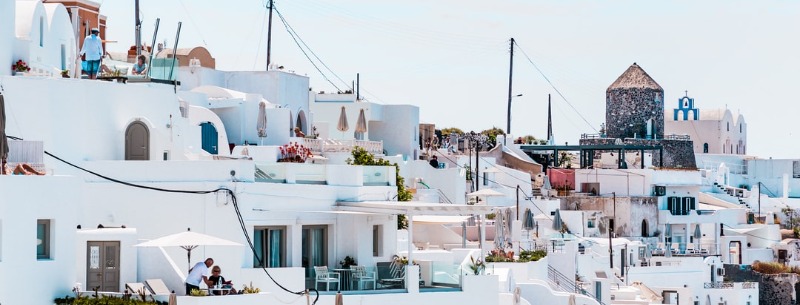Salamina is one of the Saronic Islands less than an hour’s ferry trip off Greece’s west coast, although not many tourists head that way. It’s a beautiful island, but tourism is not encouraged, perhaps because of the NATO naval base situated there, so you won’t find much written about Salamina in tourist books. The island seems ‘forgotten’, shunned by everyone but the locals and Greek mainlanders who have summer homes there.
Paloukia
Paloukia, the island’s main port on the east side of the island, is Greece’s second largest port. The harbor is crowded with vessels: ferry boats, fishing vessels and port police craft. Off to the east as you come into port, you can see the naval ships of the Salamis Naval Base. This has given Salamina the reputation of being uninviting and polluted. What people don’t know is that this beautiful island of pine-forested mountains, has dozens of sandy beaches, attractive little villages and a multitude of hidden treasures.
I’ve been to Salamina several times to visit a friend who lives there. This time my friend and I decided to search for these ‘secret’ locations that not even the locals are inclined to explore. Using a poorly marked map we set off by car to see what we could find. This is one of Greece’s largest islands (36 sq. miles. 93 km), so to get around you really need a car, although the local buses transport you from Paloukia to the many villages and beach areas. Much of the island is rocky and mountainous. The roads wind through the fragrant scented pine forest providing spectacular scenic views.
Salamina is best known historically for the famous Battle of Salamis back in the 5th century BC when the Greek fleet, led by Themistocles, defeated the invading Persians in a decisive victory. On a small peninsula known as Kynosoura (‘dog’s tail’) there are the remains of a tumulus thought to be the burial site of Greeks who fell in the Battle of Salamis. The ancient harbor is marked by a modest memorial stone. Farther up the hill on a gravel road we came to a magnificent statue depicting two Greek warriors astride the prow of a ship. Recently a film company wanted to use this original site to make their film about the battle but they were prohibited from doing so and had to move the filming to Romania. This may have had something to do with the naval base, but it seemed a shame that they were unable to photograph in the original harbor.
Cave of Euripides
My friend has already explored one of the hidden sites on the island : The Cave of Euripides, where the fabled dramatist lived and wrote. He was born on Salamina in 480 BC, the same day as the historic sea battle .

This is the cave where Euripides often went to meditate and write most of his works. In the same area there is a Sanctuary of Dionysus. I didn’t attempt the rather difficult climb to the cave as it is a strenuous trek up the mountain, but the idea spurred my imagination to find more of the undisclosed archaeological sites that dot the island.
Kanakia
We drove to the seaside village of Kanakia where up on the hillside are the remains of the acropolis of the ancient city of Ajax the Great, the legendary king and hero of the Troy War. What we were looking for that day was an unmarked site on the mountain where it was said there was a monument to Ajax. It was from this seaport he had taken his ships to join Agamemnon and Menelaus in their quest to retrieve the kidnapped Helen at Troy.
 The gravel road was rutted and not well marked so we parked the car and decided to hike up the hill. As usual, there were no signs pointing to the site so we just guessed from a vague mark on the map. At the top of the hill I heard scraping sounds coming from the forest.
The gravel road was rutted and not well marked so we parked the car and decided to hike up the hill. As usual, there were no signs pointing to the site so we just guessed from a vague mark on the map. At the top of the hill I heard scraping sounds coming from the forest.
“Let’s go look!” I suggested.
We left the road and wandered into the stand of pine trees. We hadn’t walked far before we found a group of young men and women digging among some ruins, archaeological students from the University of Ioannina. They directed us farther through the trees to another site to meet their professor, the eminent archaeologist Prof. Yannos Lolos who has been in charge of all the archaeological digs on Salamina for several years. He was happy to stop his work to talk to us and show us what it was they were excavating.
“We believe this to me a memorial to Ajax,” he explained. “We’ve located shards with the letter ‘A’ and the letter ‘J’ but we need the whole name intact in order for us to make this positive proof.”
Prof. Lolos made the discovery of the palace ruins at Kanakia, a Mycenaean-era palace attributed to the Homeric hero. He explained how Ajax would not have been buried on Salamina because he committed suicide after he was not rewarded Achilles’ armour. However, he is certain that what they are excavating on the mountain is a memorial built to honour the legendary warrior-king who had played a significant role in the Trojan Wars.
Ruins
He showed us the Classical ruins that cover part of the Mycenaean Bronze age site, pointing out a place of worship and other cult areas. We were allowed to handle shards of pottery that the students had unearthed and Prof. Lolos explained how they would be carefully cleaned. His discoveries on Salamina have been hailed by Classicists and later, when we went to the archaeological museum at Paloukia we saw many displays of artifacts that were discovered from sites that Prof. Lolos has excavated. These include the Cave of Euripides.
17th century monastery
There are not only ancient sites hidden away on the island. There are monasteries and Byzantine churches as well. We visited the 17th century monastery of Agios Nikolaus. Across from it, amid the pine forest is the tiny white chapel of Agios Ionannis built in the 10th century, the oldest church on the island.
Monastery of Virgin Mary Faneromeni
The Monastery of Virgin Mary Faneromeni is located on the western part of the island. It is famed for the 3,597 figures of saints depicted in the main church. This monastery played a significant role during Greece’s War of Independence in 1821 against the Turks. Unfortunately the day we went, it was closed.
Across the road, overlooking the ocean, is the pristine white house of Angelos Sikelianos, a distinguished poet. There is a small monument in his honor on the beach. The poet wrote some of his most well-known works here until he died in 1951. The house is now a museum.
 In the city centerof the town of Salamina is the church of Agio Dimitrios, founded in 1806. It contains a pulpit and throne carved by famed sculptor Giannoulis Halepas. The frescoes are by local painter Polychronis Lempesis. High above the town on the Patris Hill is the Church of Virgin Mary Eleftherotria, erected as a votive monument by local women in October 1944 when the Germans withdrew from the island. Nearby, with a sweeping view of the bay where the Battle of Salamis took place, is the Euripidean Theatre which hosts cultural events and dramas.
In the city centerof the town of Salamina is the church of Agio Dimitrios, founded in 1806. It contains a pulpit and throne carved by famed sculptor Giannoulis Halepas. The frescoes are by local painter Polychronis Lempesis. High above the town on the Patris Hill is the Church of Virgin Mary Eleftherotria, erected as a votive monument by local women in October 1944 when the Germans withdrew from the island. Nearby, with a sweeping view of the bay where the Battle of Salamis took place, is the Euripidean Theatre which hosts cultural events and dramas.
Museum of History and Folk Art
We visited the Museum of History and Folk Art in Paloukia which displays the everyday life of Salamina’s inhabitants over the years. It’s open Monday to Friday 9 am to 4 pm. After our museum visit we stopped across the road at taverna for refreshments. The tavern, O Perikles, is a curio-shop of interesting objects collected by the gregarious owner who welcomed us in the traditionally warm Greek manner and regaled us with stories of how he had entertained the film crew who had come to film the movie about the famous sea battle. We made a note to stop in again the next time we were in town.
Beach
At the end of each afternoon of our three days of exploring we visited the beaches. There are many choices of sandy beaches where you can relax in the sun and enjoy refreshments at local tavernas where we dined on fresh seafood and local delicacies. The island has dozens of these cozy enclaves. It’s easy to relax in the scenic village resorts of Salamina without the hordes of tourists who usually crowd the beaches of Greek islands. Maybe it’s for the best that the islanders have discouraged tourism, treasuring these well-kept secrets for themselves.
